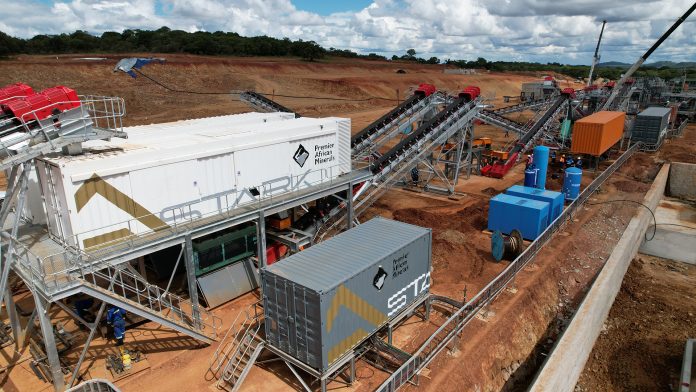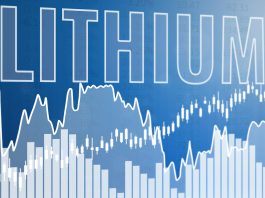STARK Resources offers the integration of trailblazing tech-based solutions to clients ranging from greenfield projects in remote bush or outback, to mature plant accretion in the heart of Tier 1 mining districts.
Stark Resources is a specialised, privately held engineering group, with a global mining footprint. It focuses on fast-tracked design and construction of mineral processing plants on a fixed price basis (EPC/LSTK) and specialises in delivering projects in developing countries and Tier-1 jurisdictions. This expertise bridges the understanding of in-ground ore deposits with tailored ore sorting technology solutions, ensuring a compelling and economically viable proposition across the entire mining value chain, from Greenfield exploration projects to active production mines.
So, who are the operators STARK chooses to partner with?
This piece can only provide a brief overview of STARK’s strategy – but should help to bridge the gap between what the company has to offer, and projects in need of a novel approach. Firstly, STARK serves three types of clients:
- Smaller companies in need of a pilot plant, to start bringing in revenue within months;
- Mature operations looking to ameliorate already profitable operations; and
- Clients that require amenability for ore sorting taking into consideration ore body analysis.
Each client, and their asset, may or may not be suitable for STARK’s various technical solutions.
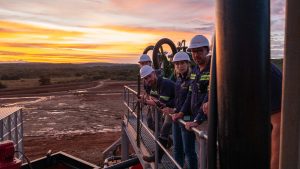
Who are STARK Resources?
STARK was founded in 2014 by a team of engineers with decades of experience. The company is led by CEO Geoffrey Madderson, COO Jaco Prinsloo, and CTO Fabian Riedel – whose names are well-known across the wider mining industry.
Executive management also includes Dian Heinrich Page, Group Commercial Director, alongside Mundus Smit, Group Financial Director, and Jean Flouhr, Rheinhardt Peens, and Willem-Daniel van Dyk as Managing Directors of Angola, Australia, and Namibia, respectively.
STARK may be new by mining standards, but it is staffed and managed by mining pedigree, many of whom have previously enjoyed careers across disciplines such as geology, engineering, mine engineering, mineral processing, construction, and original equipment manufacturing (OEM) at large-scale operators including TOMRA. Many companies have a core skillset and outsource auxiliary functions, but STARK’s diverse personnel base means it can rely on in-house skills in more areas.
The business is small yet agile enough that every client matters. Its size ensures flexibility and independence not possible elsewhere and means that the entire team can converge on one project at critical junctures.
Alongside STARK’s focus on innovative technological mining solutions, the company prides itself on being a modern force for the industry. Its processes centre around strong environmental, social and corporate governance (ESG), including:
- Environmental benefits, such as reduced chemical and water usage;
- Growing the number of women in mining, highlighted as a key problem by McKinsey in 2021, which considers that women make up only 8-17% of the global mining workforce;1 and
- Ensuring the transfer of technical skills and knowledge to local personnel.
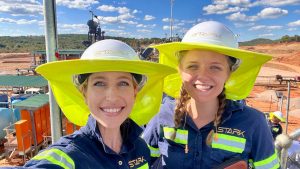 STARK clients can benefit from STARK’s ESG credentials as there are multiple grants available for ESG-focused projects. Moreover, ensuring knowledge transfer and hiring locals is often a prerequisite for any western company planning to exploit resources in Africa.
STARK clients can benefit from STARK’s ESG credentials as there are multiple grants available for ESG-focused projects. Moreover, ensuring knowledge transfer and hiring locals is often a prerequisite for any western company planning to exploit resources in Africa.
STARK works in partnership with the world’s leading mining technology companies and OEM mineral recovery processing suppliers to drastically cut mining waste.
Most importantly, its technology is applicable to more than just lithium assets – wherever sorting is an appropriate solution, STARK can be found, but its core focus remains in lithium, copper, cobalt, nickel, and gold assets.
Orebody analysis: First and foremost
A common thread throughout this piece is that STARK is different. Where larger engineering and engineering, procurement and construction management (EPCM) firms may install conventional equipment, STARK sticks to an unofficial motto – ‘start from the deposit’ – setting it apart from the competition. From there, its philosophy is to fully integrate ore sorting into mineral processing and mining flow sheets, unlike OEMs who might supply the ‘box’ solution. STARK will also find the unique recovery solution within its flowsheet model, integrating the sorter including construction, to ensure optimal recovery is achieved as envisioned during asset test work.
There are dozens of considerations for the correct integration of ore sorting into a plant: ore characteristics; correct feed size; preparation and feed rates; sensor calibration; conveyer speed and tonnage; washing of the ore; optimal calibration and sensor setup, and belt occupancy with feed presentation to prevent masking effects – care to ensure every part of the plant is correctly adjusted. Since every deposit is different, ore bodies require different assessment techniques and different technical solutions.
STARK boasts a robust team of seasoned geologists and engineers, each possessing unique commodities experience within the mining value chain. Drawing from a deep understanding of the resource model and the ore body’s geological behaviour, STARK’s advisory team leverages a comprehensive gap analysis – encompassing geology, geotechnical engineering, mine planning and engineering, metallurgy, metallurgical test work, ore sorting tests, and mineral processing designs – to tailor recovery solutions.
By using existing resource and mining models, the company integrates ore body characterisation with mineral processing parameters to project the best recovery and extraction potential. STARK’s deposit-first ideology key points include:
- Orebody assessment is time-consuming and complex. But it is critical for the team to make an informed decision concerning what tech should be used to develop an asset;
- Depending on the initial analysis, it may be that STARK’s tech is not suitable and traditional methods are the best way forward. It’s important to accept when to keep a plant as it is; and
- STARK will only proceed where there is a clear, measurable economic benefit to the client.
While ore sorting can be an extremely effective solution, it cannot always replace traditional dense media separation (DMS). It’s usually the case that ore sorting in combination with DMS is the best approach.
Greenfield projects and mature plant accretion
While some clients contract STARK solely for turnkey modular plant integration projects, the majority can be split into two camps seeking the company’s integrated solutions.
Designing and building a pilot plant from scratch at a greenfield site
• Generates revenue within months;
• Enjoys a rapid payback time of capital expenditure;
• Demonstrates the economic viability of the deposit faster than the traditional definitive feasibility study (DFS) route, or in combination with an adapted DFS programme;
• Benefits from state-of-the-art technical prowess not available elsewhere; and
• Trains and supports local workers through knowledge transfer.
The beauty of STARK’s modular pilot – or demonstration – plant approach is that the team can start by installing the minimum necessary components and then add further modules as necessary. This helps limit costs for the client; a key consideration as most exploratory miners are constrained by financing.
STARK operates within this specialist niche, building plants within a sweet spot of capital expenditure of between $40-50m. This is too little to make clients a priority at larger developers. Smaller companies can’t always go down the terminally expensive and lengthy route of developing a pre-feasibility study, a definitive feasibility study, and then the multiple other usual considerations that come before finally setting up a DMS plant. This would be preferable, but more than one company has run out of money while dreaming up grand designs.
Instead, STARK offers clients (with the correct orebody) the opportunity to get revenue up and running after some initial mineral characterisation, while also providing the opportunity to learn more about their deposit and make it more attractive for further financing. Better still, STARK will train client employees to ensure sufficient knowledge transfer and a smooth handover after commissioning is finalised. The company will never sign off a plant until it is operating to specification: this is a complete turnkey solution.
Augmenting mature brownfield plant operations
- Installs integrated modular solutions, which can be ready within two weeks of arrival on site;
- Increases minable tons, reclaim waste dumps, divert ore types to access previously inaccessible revenue, decrease haulage costs and reduce tailings;
- Reduces water consumption by up to 100%, and energy consumption by up to 80%; and
- Minimises reagent use.
After an initial orebody analysis, the focus is on immediate cash benefits, as all improvements which result in an increased yield from the orebody constitute 100% additional profit. This means that there is a rapid payback time for clients, often of only a few months.
Many potential clients are labouring under misconceptions surrounding ore sorting advances. The most common fallacy is that testing an orebody once for ore sorting suitability is enough. However, the sensors and software advancements available with modern technology have evolved, and many assets have only been tested with one type of ore sorter. STARK uses the most advanced orebody analysis techniques to check whether a different approach might yield positive results and are able to source ore sorters from the entire market.
Beyond this, assets need to be comprehensively tested, with multiple samples taken from material including a high, low, and average expected feed. Blue chip operators also sometimes think that they might need higher capacities than STARK can provide, but it’s often the case that only a small segment, or a specific size class, of total feed streams needs to be sorted for value add.
Other quibbles can include fears that original plant designs didn’t include sorting, or that it adds an extra layer of complexity to a simple, already smooth operation. The truth is that the technology STARK independently integrates and correctly applies from various OEM ore sorter suppliers reduces downstream chemical processing requirements and tailings, which makes the operation easier as well as cheaper. STARK typically starts optimisation by conducting processing plant studies, analysing the entire system to uncover ways to enhance the plant.
STARK Resources ore sorting technology in brief
STARK has access to multiple cutting-edge technologies designed to improve asset operations. The company’s modular plants are designed to be semi-movable, as well as to take advantage of cost-effective selective milling, magnetic separation, and gravity separation technology including spirals.
However, the key technologies at the centre of its operations that set STARK apart are RFID tracers, XRT sorters, and UV lasers, which are sourced from various OEM partners:
Ore sorting technology
STARK is OEM agnostic, meaning that it is not tied to a specific equipment manufacturer. The company maintains a Master Services agreement with SRC as its preferred partner in North America, for independent test work of various OEM equipment for ore sorting amenability — and will match the most appropriate equipment to each individual orebody as part of its integrated approach.
Recent success stories of XRT sorting can be found at a Tier 1 Gold operator in Tanzania, Burgundy Diamonds in Australia, and Letšeng Diamonds recovered the Lesotho Legend – the largest diamond in Lesotho.
XRT sorting is based on the mining principle that different materials absorb X-rays to varying degrees. For example, lithium-bearing ores absorb X-rays differently to waste materials such as clay or waste rock. By measuring the intensity of the X-rays which make it through material, XRT sorting equipment can distinguish between valuable and worthless material, like a doctor can distinguish bone through soft tissue on an X-ray scan. Waste rock liberation through XRT sorting is typically coarse (within the -50 to +10mm fraction), and high capacity, targeting the higher atomic density of waste rock. It’s this increased density which sees waste removed from the material, improving the ore grade being fed into subsequent units. While this process can be achieved through other types of sorters (including NIR, colour, and laser), XRT sorting is the usual standard.
Of course, you often only need XRT sorting to generate a saleable product. However, where a product still needs to be upgraded – in the case of lithium, up to SC6 quality – the company then rolls out its unique selling point: the world’s first UV laser sorting. Although STARK doesn’t develop or supply the technology itself, the company facilitated the integration of the world’s first UV sorting application in hard rock lithium mining. The valuable material that has made it through the XRT sorters is sent through the plant process to UV sorters.
Lithium recovery solutions
In a lithium operation, UV sorters separate spodumene from its host rock, and are unique in that they can directly ‘see’ the spodumene. It requires the spodumene to be well liberated but usually achieves larger mass reductions and lower losses.
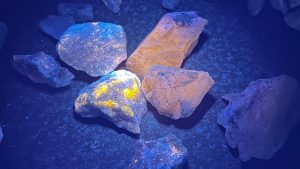
The process works by exploiting the intrinsic chemical properties of a target mineral – with spodumene, the unique UV fluorescence of its crystal lattice impurities, which is an obvious difference to waste rock. Before running an amenability UV sorting test, samples are subjected to spectral analysis to find the optimum sorting configuration settings. UV lasers and sensors are used to scan ore particles, creating raw images of processed material. The technology then merges the raw images to classify the ability of an ore particle to fluoresce within a pre-set range. On site, an ore particle that can fluoresce shows up green from multiple angles, while other materials will appear grey.
STARK has evidenced that adding a dry beneficiation stage of laser sorting can increase profit by up to 390% within two years, compared to a traditional DSO crushing and screening plant, depending on the liberation size of the ore. STARK can deliver a high-grade solution direct to site in a container, ready for plant integration, and explicitly designed to speed up access to SC6 from complex ores.
For perspective, clients who implement a STARK modular plant design, combining XRT sorters alongside laser ore sorting, can see a traditional DSO yielding 1.5% Li2O upgrade to between 3% Li2O in a conservative scenario, and 6% Li2O (SC6). In addition, STARK can build an entire pilot plant, including the laser ore sorter beneficiation for spodumene selectivity, in less than a year.
Other than the direct financial benefits of producing SC6, plant augmentation also means that the operation will run more efficiently, and reduce transport expense, as you ship a higher quality product and less waste. It’s a more environmentally friendly way to mine, and the company won’t implement its ore sorting tech without conducting an amenability test to identify the potential profit gain over a realistic period.
It bears repeating: STARK starts with the deposit.
For initial sales, contact Dian Heinrich Page, STARK’s Group Commercial Director, at dian@stark-resources.com, where he will be happy to assist.
References
1. Why women are leaving the mining industry and what mining companies can do about it | McKinsey
Written by Charles Archer
Watch our demo video here:
Please note, this article will also appear in the fifteenth edition of our quarterly publication.

